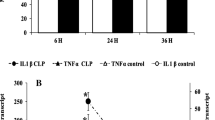Abstract
Objective: The cause of the metabolic disturbances in sepsis remains uncertain, but there is increasing evidence suggesting that haemodynamic changes are not solely responsible. We addressed the question of whether endotoxin has a significant effect on cellular oxygen metabolism, independent of confounding haemodynamic defects.
Design: Prospective, controlled experimental study.
Setting: University Laboratory.
Model: Human hepatocyte cell line.
Methods: The oxygen consumption rate (OCR) was calculated from the fall in oxygen tension in a sealed cuvette containing Hep G2 cells in suspension. The oxygen tension was measured by porphyrin phosphorescence half-life analysis. Resting OCR was measured in control cells and after 1, 6 and 24 h of endotoxin exposure. In a second series of experiments, resting and maximal OCR was measured after 6 and 24 h of endotoxin exposure and in control cells using the addition of a mitochondrial uncoupler (FCCP); this uncouples the respiratory chain from ATP synthesis, thereby removing negative feedback and allowing the respiratory chain to work at maximal rate.
Results: Endotoxin caused a rise in resting OCR at 1 h which was significant by 6 h but had returned to control values by 24 h. Maximal OCR also increased at 6 h, however exposure to endotoxin for 24 h significantly reduced maximal OCR compared to the control cells.
Conclusions: Endotoxin has complex effects on cellular energy metabolism causing an initial rise in the oxygen consumption rate and a significant limitation in oxygen consumption capacity at 24 h. These complex effects would be in keeping with the varied responses seen in patients.
Similar content being viewed by others
References
Bone RC, Balk RA, Cerra FB, Dellinger RP, Fein AM, Knaus WA, Schein RM, Sibbald WJ (1992) Definitions for sepsis and organ failure and guidelines for the use of innovative therapies in sepsis. The ACCP/SCCM Consensus Conference Committee. American College of Chest Physicians/Society of Critical Care Medicine. Chest 101: 1644–1655
Rosser DM, Stidwill RP, Jacobson DJ, Singer M (1996) Cardiorespiratory and tissue oxygen dose response to rat endotoxemia. Am J Physiol 271: H891–895
Horan MA, Little RA, Rothwell NJ, Strijbos PJ (1989) Comparison of the effects of several endotoxin preparations and body temperature and metabolic rate in the rat. Can J Physiol Pharmacol 67:1011–1014
Pathophysiology of shock, sepsis, and organ failure. (1993) Schlag G, Redl H (ed) Springer, Berlin, pp 1019–1119
Astiz M, Rackow EC, Weil MH, Schumer W (1988) Early impairment of oxidative metabolism and energy production in severe sepsis. Circ Shock 26: 311–320
Fink MP (1995) Clinical trials for the treatment of sepsis. In: Sibbald WJ, Vincent J-L (eds) Update in Intensive Care and Emergency Medicine. Springer, Berlin, p 114
Rosser DM, Stidwill RP, Jacobson DJ, Singer M (1995) Oxygen tension in the bladder epithelium rises in both high and low cardiac output endotoxemic sepsis. J Appl Physiol 79:1878–1882
Boekstegers P, Weidenhofer S, Pilz G, Werdan K (1991) Peripheral oxygen availability within skeletal muscle in sepsis and septic shock: comparison to limited infection and cardiogenic shock. Infection 19: 317–323
Boekstegers P, Weidenhofer S, Kapsner T, Werdan K (1993) Continuous measurement of peripheral oxygen availability in skeletal muscle of patients with infection. Infusionsther Transfusionsmed 1: 21–28
Boekstegers P, Weidenhofer S, Kapsner T, Werdan K (1994) Skeletal muscle partial pressure of oxygen in patients with sepsis. Crit Care Med 22: 640–650
Wilson DF, Vanderkooi JM, Green TJ, Maniara G, De Feo SP, Bloomgarden DC (1987) A versatile and sensitive method for measuring oxygen. Adv Exp Med Biol 215: 71–77
Robiolio M, Rumsey WL, Wilson DF (1989) Oxygen diffusion and mitochondrial respiration in neuroblastoma cells. Am J Physiol 256: C1207–1213
Kuttner RE, Apantaku FO, Schumer W (1981) Glucocorticoid effect on glycolytic intermediates in septic rat heart. Adv Shock Res 5:103–111
Lang CH, Bagby GJ, Blakesley HL, Spitzer JJ (1987) Glucose kinetics and pyruvate dehydrogenase activity in septic rats treated with dichloroacetate. Circ Shock 23:131–141
Hotchkiss RS, Song SK, Neil JJ, Chen RD, Manchester JK, Karl IE, Lowry OH, Ackerman JJ (1991) Sepsis does not impair tricarboxylic acid cycle in the heart. Am J Physiol 260: C50–57
Vary TC, Siegel JH, Nakatani T, Sato T, Aoyama H (1986) Effect of sepsis on activity of pyruvate dehydrogenase complex in skeletal muscle and liver. Am J Physiol 256: E445–451
Vary TC (1991) Increased pyruvate dehydrogenase kinase activity in response to sepsis. Am J Physiol 260: E669–674
Harken AH, Lillo RS, Hufnagel HV (1975) Direct influence of endotoxin on cellular respiration. Surg Gynecol Obstet 140(6): 858–860
James PE, Jackson SK, Grinberg OY, Swartz HM (1995) The effects of endotoxin on oxygen consumption of various cell types in vitro: an EPR oximetry study. Free Radie Biol Med 18: 641–647
Schaefer CF, Lerner MR, Biber B (1991) Dose-related reduction of intestinal cytochrome a,a3 induced by endotoxin in rats. Circ Shock 33(1): 17–25
Dawson KL, Geller ER, Kirkpatrick JR (1988) Enhancement of mitochondrial function in sepsis. Arch Surg 123 (2): 241–244
Author information
Authors and Affiliations
Corresponding author
Rights and permissions
About this article
Cite this article
Rosser, D.M., Manji, M., Cooksley, H. et al. Endotoxin reduces maximal oxygen consumption in hepatocytes independent of any hypoxic insult. Intensive Care Med 24, 725–729 (1998). https://doi.org/10.1007/s001340050651
Received:
Accepted:
Published:
Issue Date:
DOI: https://doi.org/10.1007/s001340050651




